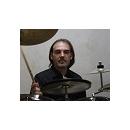Bueno, ahí van las primeras traducciones...
Alguien escribió:
My Sonor drums that I've used in the Europe for the last 3 years are Designer Maple shells.
8x8, 10x8, 12x9, and floor toms 14x12, 16x14 and a 22x17 bass drum in Earth finish.
Heads in the studio and live are coated emperors on the tops of the toms and either clear ambassadors on the bottoms or coated diplomats on the bottoms.
In the studio I would use a coated pinstripe or a CS Dot on the snare top. Live I use an EmperorX - it’s a bit heavy but the only one that will see me through the whole show without pitting too badly. Probably I can use the EmperorX for 2-3 shows maximum before I have to change it.
The bass drum has a powerstroke 3 clear on it and inside the drum it's about a 1/3 full of heavy pillows. Yep I like a dead bass drum. I noticed that live it's really hard to get a good punchy bass drum to come through a PA unless it's really dead, because most venue PA's will extend the note of the kick making it really un-usefully long. In fact PT's sound engineer gates the length of the bass drum to make it really short. Sometimes I ask him to turn the gate off and suddenly it sounds like an 808 sample with long sustain.
Also the bass drum is MUCH easier to play a double pedal on when it’s got a pillow pressed up against it. Acoustically it’s a bit of a 80’s Jeff Porcaro sound but when it’s amplified it sounds good to me.
The only strange thing I do with a snare drum is I normally put 12 strand puresound snares on it - but I cut down the outside strands so there’s just 8 left in the middle. It sounds better and feels better to play - just my preference.
For the last couple of tours I used the Sonor black steel 14x5 snare and it was consistently good in different rooms. I normally carry a few other snares but this one just sounded great so I used it every night.
La batería Sonor que he estado usando en Europa durante los tres últimos años es una Designer con cascos de arce: 8x8, 10x8 y goliaths de 14x12, 16x14 y bombo de 22x17 en acabado Earth.
Los parches, tanto en el estudio como en directo, son Coated Emperors como batidores y Clear Ambassador como resonantes, o Coated Diplomats.
En el estudio utilizo un Coated Pinstripe o un CS Dot como batidor en la caja. En vivo, uso un Emperor X -es un poco
heavy, pero es el único que me aguanta durante todo el show sin quedar demasiado picado. Más o menos puedo utilizarlo durante dos o tres actuaciones como máximo antes de tener que cambiarlo.
El bombo lleva un Powerstroke 3 Clear, y en el interior está relleno en un tercio con almohadones grandes. Sí, me gustan los bombos apagados. He notado que en directo es realmente difícil obtener un bombo bien duro de los PA's a no ser que esté bien apagado, porque la mayoría de los sistemas de PA alargan la nota del golpe del bombo inútilmente. De hecho, el ingeniero de sonido de Porcupine Tree puertea el bombo para hacerlo realmente corto. A veces le pido que apague la puerta de sonido y de pronto suena como un sample 808 con sustain largo.
Además, el doble pedal es MUCHO más fácil de golpear cuando tiene un almohadón presionando contra la maza. Acústicamente es un sonido un poco como el de Jeff Porcaro en los '80, pero amplificado a mí me suena muy bien.
La única cosa rara que hago con la caja es que normalmente le pongo bordonera de doce alambres, pero corto los alambres exteriores, así que sólo quedan los ocho del medio. Suena mejor y se siente mejor al tocar - tan sólo es mi preferencia.
Para mi último par de tours he usado la caja Sonor de acero negro 14x5 y era consistentemente buena en diferentes recintos. Normalmente llevo otras pocas cajas más, pero ésta justamente sonaba muy bien, así que la he usado cada noche.
Alguien escribió:
On my snare I use a very slim "O" ring. In fact I've made about 6 or 7 "O" rings that are all less than 1" wide and I try different permutations of them (sometimes two together) until I get the amount of dampening that I want.
En mi caja utilizo un anillo "O" muy delgado. De hecho, he hecho seis o siete anillos "O" que son todos ellos menos de 2,5 cm. de ancho y he intentado diferentes combinaciones con ellos (a veces, dos juntos) hasta encontrar el amortiguamiento que quiero.
Alguien escribió:
Many people have asked me about those little bell cymbals. They are in fact home made out of old broken 16" Zildjian crash cymbals that I had in my garage.
So I cut 5 of them down. The biggest one is just over 6" and the smallest is just under 5". The smallest one is actually made from a broken splash cymbal.
Then I got a friend of mine to make me a little bar to mount them on. Simple as that.
Mucha gente me ha preguntado por esos pequeños platos de campana. De hecho, son fabricados de forma casera partiendo de viejos crashes Zildjian de 16" rotos que tenía en el garaje.
Así que corté cinco de ellos. El más grande es un poco mayor de 6" y el más pequeño es un poco menor de 5". Éste está hecho a partir de un splash roto.
Y tengo un amigo que me hizo una pequeña barra para montarlos. Tan simple como eso.
Alguien escribió:
Hi e7z,
I'll try to answer your questions.
I use these microphones
Audix D6 at the from hole of the bass drum - no eq - about 2 inches away from the skin
Audix i5 on the snare top - little bit of 12khz boost eq - about 2 inches away from the skin
Shure SM57 for under snare - reverse phase - no eq
Electro Voice ND408 on the toms - no eq
2 Royer 122 ribbon mics as stereo overheads - reverse phase - no eq
AKG ck391 on the hi hat - low frequencies cut eq
2 Scheops CMC5 as stereo room mics.
They are connected to the desk and then into the Apogee Rosetta 192 digital converters - and into Logic Pro 7 software on my Mac G5.
Sometimes I use the Waves C1 compressor on the snare top and sometimes on the overheads. Sometimes I use the Space Designer reverb which is part of Logic Pro software.
I try to record the whole song in one performance. Maybe I will make 3 whole performances that I like and cut from one to another - but try to keep as much of one performance as possible. I don't like to record in little pieces and then assemble -
because I can hear that it's not continuos.
Utilizo estos micrófonos:
- Audix D6 en el agujero frontal del bombo -sin ecualizar-, a unas dos pulgadas (cinco centímetros, n del t.) del parche.
- Audix I5 en el batidor de la caja -un poco de realce de ecualización a los 12khz- unas dos pulgadas (5 cm., n del t.) del parche.
- Shure SM57 en el resonante de la caja -fase invertida-, sin ecualización.
- Electro Voice ND408 en los toms, sin ecualización.
- 2 Royer 122 de cinta como aéreos estéreo -fase invertida-, sin ecualización.
- AKG CK391 en el hi-hat, con la ecualización recortando las frecuencias bajas.
- 2 Scheops CMC5 como micros de sala estéreo.
Todo conectado a la mesa y luego a convertidores digitales Apogee Rosetta 192 -y a software Logic Pro 7 en mi Mac G5.
A veces utilizo el compresor Waves C1 en el batidor de la caja, y de vez en cuando en los aéreos. A veces, uso la reverb Space Designer, que es parte del software Logic Pro 7.
Intento grabar toda la canción en una sola toma. Posiblemente realizo tres tomas completas que me gustan y voy cortando de una a otra. Pero intento conservar el máximo de una misma toma como sea posible. No me gusta grabar en pequeñas partes y luego ensamblarlas, porque puedo oír que no es continuo.
Alguien escribió:
I find that if my snare is buzzing when I play the toms - it's usually just one tom (the one in front of me) where the pitch is very similar. If you turn your snares off and listen to the pitch of the snare drum - and then compare it with the offending tom - you should find they are in the same pitch zone, so you must decide if you want to raise the pitch of the snare or the tom. It doesn't matter - as long as they are significantly different.
I also cut down my snare wires from 12 strands to 8. Cutting the outside 4 off.
Cuando mi caja resuena si toco los toms -normalmente es el tom que tengo enfrente, cuyo timbre es muy similar-, apago la bordonera y escucho el timbre de la caja, y lo comparo con el del tom rebelde. Deben estar en la misma banda de timbres, así que debes decidir si prefieres subir la afinación de la caja o la del tom. No importa, ya que son significativamente diferentes.
Yo además corto los alambres de mi bordonera hasta que quedan ocho, cortando los cuatro exteriores.
Alguien escribió:
I've been playing Axis Longboards for a few years now. Slightly different feel from other pedals I've used - but I could instantly play things on them I was only dreaming of before. After that - there was no going back.
I didn't get on well with the Sonic Hammers - so I use the 2 way Pearl beaters.
He estado tocando Axis Longboards durante unos años. Sutilmente distintos de los otros pedales que he usado. Pero enseguida pude tocar con ellos cosas con las que sólo había soñado antes. Después de eso, no hubo vuelta atrás.
No me acaban de encajar los Sonic Hammers, así que utilizo las mazas Pearl de dos
caras.








 , sino en el foro de drummerworld:
, sino en el foro de drummerworld: